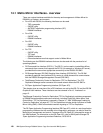
152 IBM System Storage DS6000 Series: Copy Services with IBM System z
The TSO commands communicate with the DS6000 through a device number specified in the
command. IP connectivity is not required.
TSO commands can be integrated into REXX programs for automation purposes.
14.2.1 Commands overview
Most TSO commands require the subsystem identifier (SSID) of the LSS to be specified, and
some require the channel connection address (CCA) of the volume also.
Channel connection address
Some Metro Mirror TSO commands require the use of the channel connection address (CCA)
of the device in question. The CCA on a DS6000 is always relative to the LSS, and is always
between 00 and FF. If the device numbers on the DS6000 have been generated as a
contiguous group of 256 addresses, where each group belongs to an LSS (logical control
unit), then the CCAs that are going to be used for the Metro Mirror commands are the last two
digits of the device number.
For example, for device numbers AA00 to AAFF, the corresponding CCAs are 00 to FF. If you
did not define the device addresses contiguously, you can obtain the CCA for a device by
using the TSO CQUERY command, or the DEVSERV system command.
Subsystem identifier
During the installation and configuration process, each logical control unit (that is, each LSS)
is assigned a unique four-digit subsystem identifier (SSID). This setting is required to identify
the control unit for the host for error reporting reasons and also for functions like Metro Mirror.
Each LSS must have a different SSID. The authors recommend assigning consecutive SSID
numbers to each LSS in a DS6000. This simplifies the configuration procedure and makes it
easier for the subsequent identification of the LSSs. LSSs attached to the same operating
system image must have different SSIDs; that is, SSIDs must be
unique. z/OS checks during
the IPL to ensure that there are no duplicate SSIDs.
When establishing Metro Mirror paths, the SSIDs are used in the Metro Mirror TSO
commands to identify the primary and secondary LSSs to be paired.
When issuing commands to open systems volumes from TSO commands, you use a special
SSID value. You can either use x’FFFF’, if you are unsure what the value should be, or check
the value using a CQUERY command.
14.2.2 CESTPAIR
This command is used to establish the Metro Mirror primary to secondary relationship. The
primary and secondary volumes must have the same number of tracks on each cylinder and
the same number of bytes on each track. The secondary device must have the same number,
or a greater number, of cylinders than the primary device. If you ever need to swap the Metro
Mirror direction, as in a failover/failback, then the volumes must be the same size.
Tip: if you are controlling open systems volumes with TSO commands, you must have a
z/OS volume in the same server to direct your command to. For example, for an open
systems LUN in LSS 16, a z/OS volume in LSS 00 can be used for the device address. If
you had a LUN in LSS 15, you can use a z/OS volume in LSS 01.


















